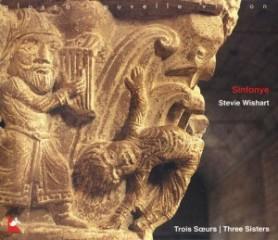Three Sisters - Songs From 13th Century France (2001)
Three Sisters - Songs From 13th Century France (2001)

1. Azeruz 2. Volez oyer le castoy, motet 3. Bele Aelis par matin/Haro, haro!/ Flos filius, motet 4. En mai/ Domine, motet 5. Nouvele amor, motet 6. Nouvele amor/ Haute amor/ E! Dame jolie, motet 7. E! Dame jolie, chanson 8. La plus bele/ Pacem, motet 9. Mainte dame/ Han, motet 10. Quant voi yver/ Au douz/ Hodie Perlustravit, motet 11. Ne m'oubliez/ Domino, motet 12. Quant voi yver/ Au douz/ Hodie Perlustravit, motet 13. J'ai mon cuer/ Letabitur, motet 14. Ja n'ert nus/ Justus, motet 15. Bien doit joie/ In Domino, motet 16. J'Ai Mon Cuer 17. J'ai n'ert nus, carol 18. Bien doit joie, carol 19. Estampie 20. Li savours / Li grant desirs / No vul maris, motet 21. Estampie 22. Avant hier en un vert pre, chanson de malmariée 23. Tuit cil/ Li jalous/ Veritatem, motet 24. Tuit cil qui sunt enamourat 25. Por conforter, motet 26. Bele Yolanz En Ses Chambres Ses Seoit 27. Entre Copin/ Je me cuidoie/ Bele Ysabelos, motet 28. Un chant renvoisie et bel / Decantatur, motet 29. Trois serors sor rive mer, motet Sinfonye: Stevie Wishart - vocals, symphony (hurdy-gurdy), medieval fiddle Vivien Ellis - vocals Jocelyn West - vocals
The three women that make up the early music ensemble Sinfonye tap into some of medieval France’s more lively and entertaining repertoire in this generously filled program of 13th-century songs and motets. Not surprisingly for performances of music from this period, the singers have assumed a certain interpretive license, not only in terms of the specifics of the vocal lines but also regarding accompaniments, which include the delightfully reedy sounds of hurdy-gurdy and medieval fiddle. In some cases, they begin with a piece in its more formal written form–a motet–and extract what probably was the original melody that inspired it. Then, they add their own “improvised” supporting voice parts and impose a more dance-like rhythmic structure. Many of the songs are reminiscent of the Cantigas de Santa Maria–the same easy singability and lively movement. The multi-part pieces show a real feel for the style and a gift for colorful harmonic invention. The first piece on the disc actually is an original work “in the spirit of a medieval motet”, whose lyrics (used “purely for their sound”) are taken from Hildegard von Bingen’s Lingua Ignota. At nearly eight minutes it’s by far the longest of the program’s 33 songs–and although it has several interesting, attractive, and effectively original features, there are just too many ideas here all strung together. Nevertheless, the performances are quite fine; the singers have strong, characterful voices whose tone (warmer here, straighter there) and mannerisms (different inflections and ornaments) they vary according to the song. Intonation is near-perfect and there’s some excellent unison singing. The sound is ideal: clear, bright, detailed, and natural. Fans of medieval vocal music, especially those who enjoy the Cantigas, shouldn’t hesitate to give this a try. --- David Vernier, classicstoday.com
download (mp3 @320 kbs):
yandex 4shared mega mediafire zalivalka cloudmailru uplea








